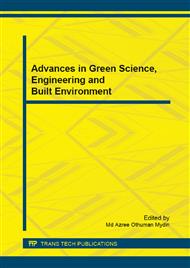[1]
A. Gillen, A. Wright, and L. Spink, Student perceptions of a positive climate for learning: a case study, Educ. Psychol. Pract., vol. 27, no. 1, p.65–82, Mar. (2011).
DOI: 10.1080/02667363.2011.549355
Google Scholar
[2]
H. Altan, Energy efficiency interventions in UK higher education institutions, Energy Policy, vol. 38, no. 12, p.7722–7731, Dec. (2010).
DOI: 10.1016/j.enpol.2010.08.024
Google Scholar
[3]
M. Sapri and S. Muhammad, Monitoring energy performance in higher education buildings for sustainable caumpus, Malaysian J. Real Estate, vol. 5, no. 1, p.1–25, (2010).
Google Scholar
[4]
M. A. Hassanain, Post-Occupancy Indoor Environmental Quality Evaluation of Student Housing Facilities, Archit. Eng. Des. Manag., vol. 3, no. 4, p.249–256, (2007).
DOI: 10.1080/17452007.2007.9684646
Google Scholar
[5]
A. L. Olanrewaju, M. F. Khamidi, and A. Idrus, Quantitative analysis of defects in Malaysian university buildings : Providers ', J. Retail Leis. Prop., vol. 9, no. 2, p.137–149, (2010).
DOI: 10.1057/rlp.2010.2
Google Scholar
[6]
D. Amaratunga and D. Baldry, Building Performance Evaluation In Higher Education Properties: Towards A Process Model, in COBRA 1999, (1999).
Google Scholar
[7]
N. Almeida, V. Sousa, L. Alves Dias, and F. Branco, A framework for combining risk-management and performance-based building approaches, Build. Res. Inf., vol. 38, no. 2, p.157–174, Apr. (2010).
DOI: 10.1080/09613210903516719
Google Scholar
[8]
R. J. Cole, Building environmental assessment methods : assessing construction practices, Constr. Manag. Econ., vol. 18, no. 8, p.949–957, (2000).
Google Scholar
[9]
T. Lützkendorf and D. Lorenz, Integrating sustainability into property risk assessments for market transformation, Build. Res. Inf., vol. 35, no. 6, p.644–661, Nov. (2007).
DOI: 10.1080/09613210701446374
Google Scholar
[10]
T. Lützkendorf and D. P. Lorenz, Using an integrated performance approach in building assessment tools, Build. Res. Inf., vol. 34, no. 4, p.334–356, Jul. (2006).
DOI: 10.1080/09613210600672914
Google Scholar
[11]
B. J. Meacham, Risk-informed performance-based approach to building regulation, J. Risk Res., vol. 13, no. 7, p.877–893, Oct. (2010).
DOI: 10.1080/13669871003703260
Google Scholar
[12]
A. Wolski, N. A. Dembsey, and B. J. Meacham, Accommodating perceptions of risk in performance-based building 're-safety' code development, Fire Saf. J., vol. 34, p.297–309, (2000).
DOI: 10.1016/s0379-7112(00)00003-5
Google Scholar
[13]
A. Zalejska-Jonsson, Evaluation of low-energy and conventional residential buildings from occupants' perspective, Build. Environ., vol. 58, p.135–144, Dec. (2012).
DOI: 10.1016/j.buildenv.2012.07.002
Google Scholar
[14]
B. P. Thompson and L. C. Bank, Risk Perception in Performance-Based Building Design and Applications to Terrorism-Resistant Design, no. February, p.61–69, (2007).
DOI: 10.1061/(asce)0887-3828(2007)21:1(61)
Google Scholar
[15]
W. F. E. Preiser, H. Z. Rabinowits, and E. T. White, Post Occupancy Evaluation. New York: Van Nostrand Reinhold Company CRS Sirrine Houston, TX, (1988).
Google Scholar
[16]
G. Mcdougall, J. R. Kelly, J. Hinks, and U. S. Bititci, A review of the leading performance measurement tools for assessing buildings, J. Facil. Manag., vol. 1, no. 2, p.142–153, (2002).
DOI: 10.1108/14725960310807881
Google Scholar
[17]
W. F. E. Preiser and J. L. Nasar, Assessing Building Performance : Its Evolution From Post-Occupancy Evaluation, Archnet-IJAR, Int. J. Archit. Res., vol. 2, no. 1, p.84–99, (2008).
Google Scholar
[18]
D. Amaratunga and D. Baldry, Appraising the total performance of higher education buildings: A participator y approach towards a knowledge- base system, in Construction and Building Research Conference 1998 : Proceedings (COBRA) 2nd-3rd September 1998, Oxford Brookes University, 1998, p.1.
Google Scholar
[19]
D. Amaratunga and D. Baldry, A conceptual framework to measure facilities management performance, Prop. Manag., vol. 21, no. 2, p.171–189, (2003).
DOI: 10.1108/02637470310478909
Google Scholar
[20]
W. F. E. Preiser, Post-Occupancy Evaluation : How to make buildings work better, Facilities, vol. 13, no. 11, p.19–28, (1995).
DOI: 10.1108/02632779510097787
Google Scholar
[21]
J. E. Woods, Expanding the Principles of Performance to Sustainable Buildings, Real Estate Issues, vol. 33, no. 3, p.37–46, (2008).
Google Scholar
[22]
B. Meacham, R. Bowen, J. Traw, and A. Moore, Performance-based building regulation: current situation and future needs, Build. Res. Inf., vol. 33, no. 2, p.91–106, Mar. (2005).
DOI: 10.1080/0961321042000322780
Google Scholar
[23]
R. Spence, Risk and regulation: can improved government action reduce the impacts of natural disasters?, Build. Res. Inf., vol. 32, no. 5, p.391–402, Sep. (2004).
DOI: 10.1080/0961321042000221043
Google Scholar
[24]
E. Meins, H. Wallbaum, R. Hardziewski, and A. Feige, Sustainability and property valuation: a risk-based approach, Build. Res. Inf., vol. 38, no. 3, p.280–300, Jun. (2010).
DOI: 10.1080/09613211003693879
Google Scholar
[25]
B. Edwards, University Architecture. Spoon Press (Taylor & Francis Group), UK, (2000).
Google Scholar
[26]
T. Malmqvist and M. Glaumann, Environmental efficiency in residential buildings – A simplified communication approach, Build. Environ., vol. 44, no. 5, p.937–947, May (2009).
DOI: 10.1016/j.buildenv.2008.06.025
Google Scholar
[27]
H. H. Ali and S. F. Al, Developing a green building assessment tool for developing countries – Case of Jordan, Build. Environ., p.1–12, (2008).
Google Scholar
[28]
M. Camilleri, R. Jaques, and N. Isaacs, Impacts of climate change on building performance in New Zealand, Build. Res. Inf., vol. 29, no. 6, p.440–450, Nov. (2001).
DOI: 10.1080/09613210110083636
Google Scholar
[29]
R. N. Whitfield, Managing Institutional Risks – A Framework, University of Pennsylvania, (2003).
Google Scholar


